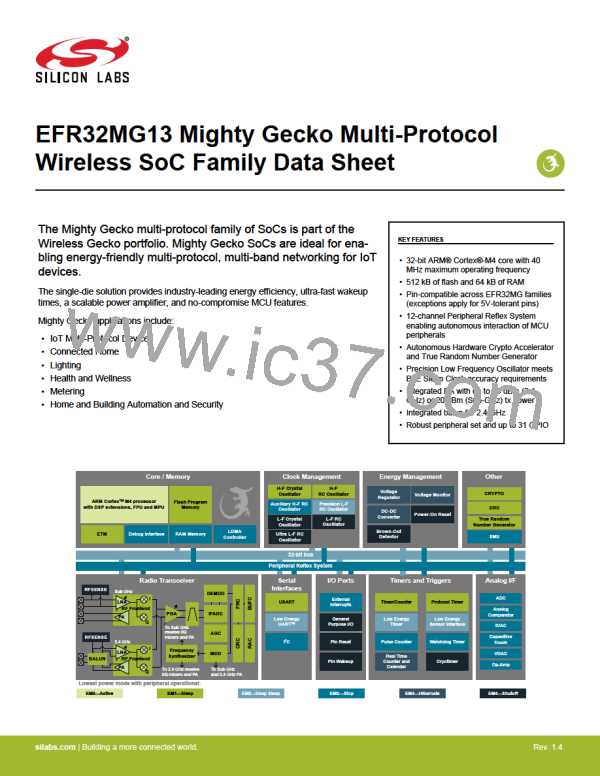EFR32MG13 Mighty Gecko Multi-Protocol Wireless SoC Family Data Sheet
System Overview
3.7.5 Low Energy Sensor Interface (LESENSE)
The Low Energy Sensor Interface LESENSETM is a highly configurable sensor interface with support for up to 16 individually configura-
ble sensors. By controlling the analog comparators, ADC, and DAC, LESENSE is capable of supporting a wide range of sensors and
measurement schemes, and can for instance measure LC sensors, resistive sensors and capacitive sensors. LESENSE also includes a
programmable finite state machine which enables simple processing of measurement results without CPU intervention. LESENSE is
available in energy mode EM2, in addition to EM0 and EM1, making it ideal for sensor monitoring in applications with a strict energy
budget.
3.8 Security Features
3.8.1 General Purpose Cyclic Redundancy Check (GPCRC)
The GPCRC block implements a Cyclic Redundancy Check (CRC) function. It supports both 32-bit and 16-bit polynomials. The suppor-
ted 32-bit polynomial is 0x04C11DB7 (IEEE 802.3), while the 16-bit polynomial can be programmed to any value, depending on the
needs of the application.
3.8.2 Crypto Accelerator (CRYPTO)
The Crypto Accelerator is a fast and energy-efficient autonomous hardware encryption and decryption accelerator. EFR32 devices sup-
port AES encryption and decryption with 128- or 256-bit keys, ECC over both GF(P) and GF(2m), SHA-1 and SHA-2 (SHA-224 and
SHA-256).
Supported block cipher modes of operation for AES include: ECB, CTR, CBC, PCBC, CFB, OFB, GCM, CBC-MAC, GMAC and CCM.
Supported ECC NIST recommended curves include P-192, P-224, P-256, K-163, K-233, B-163 and B-233.
The CRYPTO1 block is tightly linked to the Radio Buffer Controller (BUFC) enabling fast and efficient autonomous cipher operations on
data buffer content. It allows fast processing of GCM (AES), ECC and SHA with little CPU intervention.
CRYPTO also provides trigger signals for DMA read and write operations.
3.8.3 True Random Number Generator (TRNG)
The TRNG is a non-deterministic random number generator based on a full hardware solution. The TRNG is validated with NIST800-22
and AIS-31 test suites as well as being suitable for FIPS 140-2 certification (for the purposes of cryptographic key generation).
3.8.4 Security Management Unit (SMU)
The Security Management Unit (SMU) allows software to set up fine-grained security for peripheral access, which is not possible in the
Memory Protection Unit (MPU). Peripherals may be secured by hardware on an individual basis, such that only priveleged accesses to
the peripheral's register interface will be allowed. When an access fault occurs, the SMU reports the specific peripheral involved and
can optionally generate an interrupt.
3.9 Analog
3.9.1 Analog Port (APORT)
The Analog Port (APORT) is an analog interconnect matrix allowing access to many analog peripherals on a flexible selection of pins.
Each APORT bus consists of analog switches connected to a common wire. Since many clients can operate differentially, buses are
grouped by X/Y pairs.
3.9.2 Analog Comparator (ACMP)
The Analog Comparator is used to compare the voltage of two analog inputs, with a digital output indicating which input voltage is high-
er. Inputs are selected from among internal references and external pins. The tradeoff between response time and current consumption
is configurable by software. Two 6-bit reference dividers allow for a wide range of internally-programmable reference sources. The
ACMP can also be used to monitor the supply voltage. An interrupt can be generated when the supply falls below or rises above the
programmable threshold.
silabs.com | Building a more connected world.
Rev. 1.4 | 15
